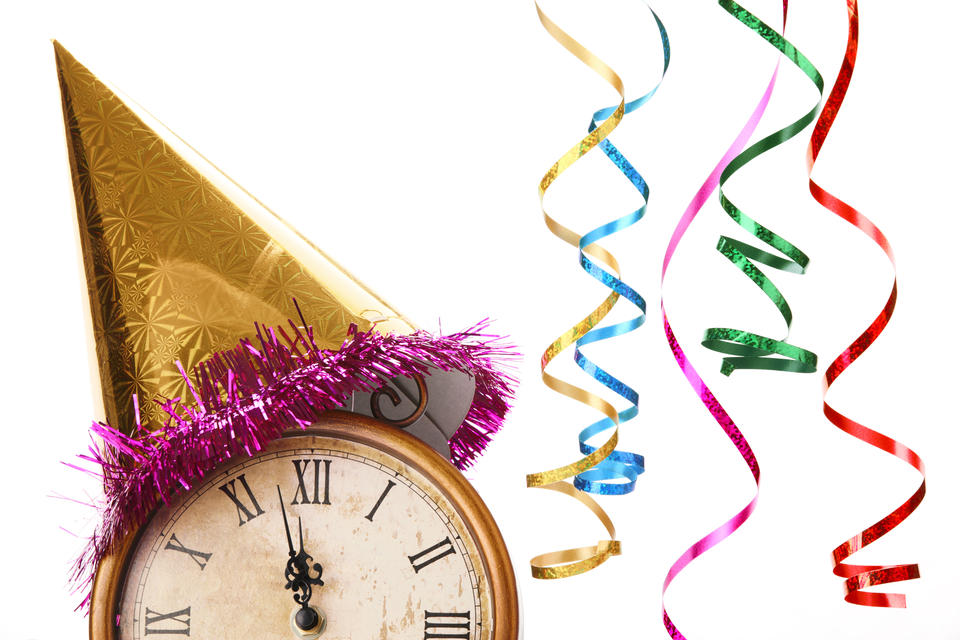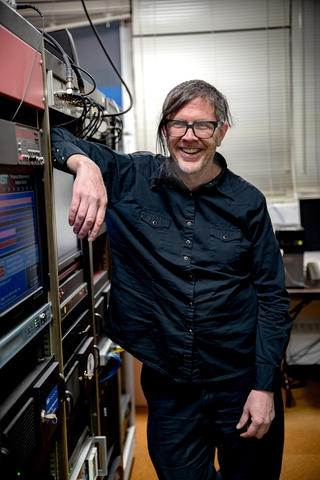Taking Measure
Just a Standard Blog
Auld Lang ‘Time’: One of the Country’s Timekeepers Makes Sure We Ring in 2024 at Just the Right Second

The new year is a great time to think about the passage of time. Here at NIST, we’re always keeping an eye on the clock. We keep official time for the U.S., which part of the worldwide weighted average called Coordinated Universal Time (UTC).
When people around the country are preparing champagne and getting ready to watch the ball drop on New Year’s Eve, I’ll be closely monitoring our clocks at NIST.
We actually monitor them every nanosecond of every day, not just on New Year’s Eve. We have the duty to uphold the official U.S. time. There are many ways we get this time out to the public, which we call “distributing” the correct time. We send out the time via satellite, radio signals, telephone lines, through internet protocols, and via our web clock at time.gov.
We always ensure that we have the exact time, but on New Year’s Eve (and daylight saving time changes), many more people are looking out for the correct time. Sometimes on New Year’s Eve, there is a leap second — it’s an extra second we add to the time worldwide to let Earth “catch up” to our official time. We haven’t had one of those in a while, but it does make New Year’s Eve even more interesting for timekeepers like me!
Keeping Time for the Country and the World
In the NIST Time and Frequency Division, to produce the official time of day, we begin by defining the duration of the second. This is actually quite complex and involves a lot of interesting science.
We are always working on better and better atomic clocks for future definitions of the second, but we also have our primary standard clocks for the current definition. These are cesium fountain clocks that measure the second by tuning themselves to the precise frequency of microwaves that are absorbed by cesium-133 atoms. We use the primary standard clocks to calibrate many commercially available atomic clocks.
By measuring and comparing all these atomic clocks, we create a clock ensemble. You wouldn’t want to have just one clock keeping time for the whole country, so we use a weighted average of the clocks for the best possible stability.
The most stable clocks get the most “weight” mathematically in the average. So, if a clock starts to show drift or has other problems, it gets less weight, so it does not affect the average. The output of this time scale is Coordinated Universal Time for the United States, known as UTC(NIST). We contribute our clock and time scale data to the International Bureau of Weights and Measures (BIPM). Our time is a part of the worldwide weighted average, which is called Coordinated Universal Time (UTC).
As primary standards improve, researchers have to develop better ways of getting time out to industry and the public. Things such as GPS, mobile phone communications and time-stamping stock market transactions require the use of precise time.
In our lab, I build measurement systems that we can use to measure clocks remotely to calibrate the clocks of our customers around the world. Our customers are institutions that need very accurate time, such as the aerospace, power grid, communication and financial industries, along with research institutions. Time is so crucial to these customers that they need accurate timing from microseconds (one millionth of a second) to nanoseconds (one billionth of a second).
Milliseconds to Nanoseconds
A millisecond is one-thousandth of one second, and a microsecond is a millionth of a second.
It’s hard to grasp, but a nanosecond is one billionth of a second. Think about the speed of light — it travels about 1 foot in a nanosecond!
So, if you turn on a flashlight, that light will have traveled a foot away from the flashlight in a nanosecond — that’s inconceivably fast.
A computer can perform millions or billions of operations in a second, and we need to be able to measure it!
There are also many important users who need accurate time but only within milliseconds. For time at this level, we have the Internet Time Service (ITS), where people can synchronize computers and other equipment/devices to our internet servers. This is built into most computer operating systems. Your computer accesses this information automatically, so you’ve probably used this service without even realizing it.
Time.gov lets you see the official U.S. time in multiple time zones at once. It actually uses your computer clock to measure the round-trip delay of the request to the NIST server, so that it can display the correct time on your screen.
Welcoming the New Year as a Time Expert

Like a lot of people, I do think about resolutions and what I want to accomplish in the new year. It is kind of arbitrary when you think about it. But this is when our calendar rolls over, so it’s a moment for folks to reflect on the past and imagine the future.
Something I find fascinating is our perception of the rate of time. Some days (and years!) go by quickly, and some drag on. When we think back to the past, even distant memories are sometimes clear, and some recent memories have already faded away.
There are studies about how our perception of time changes as we get older. Each passing day, month or year is a smaller sliver of your total life the older you get. When you’re a kid, a year is a significant portion of your life. At 80 years old, one year makes up a tiny fraction of your life and experiences.
Memories play a large role in how we perceive the passage of time. Our brains categorize and store what seems significant and flush out the repetitive or unimportant day-to-day activities. (So, this is why you may sometimes struggle to remember what you ate yesterday or if you locked the door.)
If we strive to do new things and create significant memories, time may pass by quickly as they are happening, but our stored recollections will be plentiful. Our lives may seem much longer and fuller, and I try to do this as much as possible. There is plenty of capacity in our brains, and keeping our minds active is a way to help us store and recall all the great times we have had.
Making the Most of Every Moment
As someone who thinks about time at work all day, I know there are a limited number of seconds we all get each day, so I try to maximize them. One way I try to “gain time” is trying not to sleep too much (not something I necessarily recommend, but it works for me). The less I sleep, the more time I have available to do other things of interest.
I enjoy creating experiences for people. I have been in bands and other performances and strive to produce interesting art. I have created themed food events and puzzle hunts.
Sometimes I “perform” PowerPoint presentations as an opening act at concerts. This is funny because people are not expecting it. I have done talks on conspiracy theories, bloodhounds, ossuaries (rooms or containers where bones of dead people are placed) and more.
My topics are usually vaguely related to something else happening that evening, but I never announce the topics ahead of time. Our brains remember the unexpected. So even if people don’t like it, they will remember it, even if just to complain about it the next day! Most of the projects I work on are about subverting or going beyond people’s expectations — which is what makes them interesting or memorable.
I am also an avid collector, a hobby which also relates to time. I love bits of ephemera, such as old restaurant menus, unique cereal boxes, movie/concert ticket stubs and found photographs. I like board games, toys and other objects related to TV, movies and other pop culture.
These things help me to remember my past or discover the past of others. Every object has a history. What’s the difference between an everyday object and an antique? It’s really just the passage of time or sentimental memories that give things more value to us. A pocketknife or a keychain could be unmemorable, unless it belonged to a beloved uncle who passed away. Then maybe it means more or brings up memories. That’s why family heirlooms exist.
I happen to take it a little further, using objects with unknown origin from thrift stores, estate sales or found objects to imagine or wonder about their history. Finding a family photo album or a collection of letters presents interesting information about total strangers. I once even found a stack of letters between a person in prison and their sweetie on the outside. People's things are such a fascinating glimpse into lives different from our own.
Happy New Year!
However you are celebrating New Year’s Eve, be safe, have fun, create great memories and make every nanosecond count!






Happy New Year! As we ring in the new year, here's to making every nanosecond count and creating memorable moments. Cherishing experiences, exploring history through objects, and subverting expectations—wonderful ways to navigate time's passage. May your celebrations be safe, joyful, and full of cherished memories!